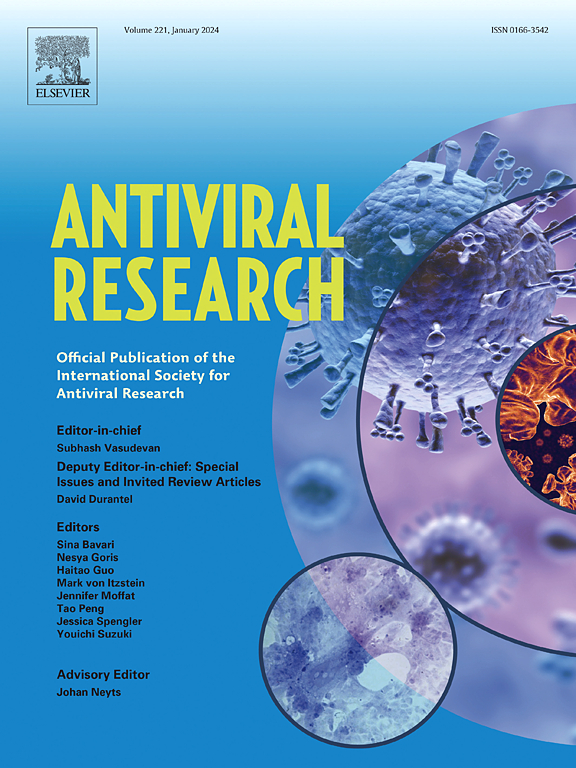CD4+ T细胞计数降低导致HIV感染者B细胞库异常改变。
IF 4.5
2区 医学
Q1 PHARMACOLOGY & PHARMACY
引用次数: 0
摘要
了解艾滋病毒感染者广泛中和抗体(bNAb)活性的演变对疫苗设计和免疫策略至关重要。有人提出,抗体交叉反应活性与HIV感染者CD4+ T细胞计数降低有关,但其潜在机制尚不清楚。为了进一步探讨抗体反应性与CD4+ T细胞计数的相关性,我们招募了CD4+ T细胞计数不同的HIV感染者:(i) CD4+ T细胞≤50个细胞/μL, (ii) 50个细胞/μL < CD4+ T细胞≤200个细胞/μL, (iii) 200个细胞/μL < CD4+ T细胞≤500个细胞/μL, (iv) 500个细胞/μL < CD4+ T细胞。我们使用4种不同亚型的SOSIP.664三聚体检测血清中的抗原特异性抗体。免疫库测序用于表征这些个体的B细胞受体(BCR)库。不同SOSIP.664三聚体抗原特异性抗体的评估显示,与CD4+ T细胞计数高/正常的个体相比,CD4+ T细胞计数低的个体的反应性增强。通过BCR高通量测序对抗体基因库进行分析发现,CD4+ T细胞计数低于50个细胞/μL的个体中,CDRH3(重链互补决定区3)环超过20个氨基酸的IgG比例增加。值得注意的是,IGHV1-46和IGHV4-34种系,提示大多数多反应性B细胞,优先用于CD4+ T细胞计数低的个体。这些结果表明,CD4+ T细胞的有限接触可以促进具有长CDRH3区域的异常B细胞库的存活。本文章由计算机程序翻译,如有差异,请以英文原文为准。
Decreased CD4+ T cell counts drive aberrant B cell repertoire alterations in people living with HIV
Understanding the evolution of broadly neutralizing antibody (bNAb) activity in people living with HIV is crucial for vaccine design and immunization strategies. It has been proposed that antibody cross-reactive activity is associated with lower CD4+ T cell counts during people living with HIV, but the underlying mechanisms remain unclear. To further explore the correlation between antibody reactivity and CD4+ T cell counts, we recruited people living with HIV with varying CD4+ T cell counts: (i) CD4+ T cell ≤50 cells/μL, (ii) 50 cells/μL < CD4+ T cell ≤200 cells/μL, (iii) 200 cells/μL < CD4+ T cell ≤500 cells/μL, (iv) 500 cells/μL < CD4+ T cell. We assessed the antigen-specific antibodies in serum using SOSIP.664 trimers from four different subtypes. Immune repertoire sequencing was used to characterize the B cell receptor (BCR) repertoire of these individuals. The evaluation of antigen-specific antibodies with different SOSIP.664 trimers showed enhanced reactivity in individuals with low CD4+ T cell counts compared to those with high/normal CD4+ T cell counts. Analysis of antibody gene repertoires through BCR high throughput sequencing revealed an increased proportion of IgG with heavy chain complementarity-determining region 3 (CDRH3) loops exceeding 20 amino acids in individuals with CD4+ T cell counts below 50 cells/μL. Notably, the IGHV1-46 and IGHV4-34 germlines, which are suggestive of most polyreactive B cells, were preferentially used in individuals with low CD4+ T cell counts. These results suggest that limited engagement of CD4+ T cells could facilitate the survival of aberrant B cell repertoire with long CDRH3 regions.
求助全文
通过发布文献求助,成功后即可免费获取论文全文。
去求助
来源期刊

Antiviral research
医学-病毒学
CiteScore
17.10
自引率
3.90%
发文量
157
审稿时长
34 days
期刊介绍:
Antiviral Research is a journal that focuses on various aspects of controlling viral infections in both humans and animals. It is a platform for publishing research reports, short communications, review articles, and commentaries. The journal covers a wide range of topics including antiviral drugs, antibodies, and host-response modifiers. These topics encompass their synthesis, in vitro and in vivo testing, as well as mechanisms of action. Additionally, the journal also publishes studies on the development of new or improved vaccines against viral infections in humans. It delves into assessing the safety of drugs and vaccines, tracking the evolution of drug or vaccine-resistant viruses, and developing effective countermeasures. Another area of interest includes the identification and validation of new drug targets. The journal further explores laboratory animal models of viral diseases, investigates the pathogenesis of viral diseases, and examines the mechanisms by which viruses avoid host immune responses.
 求助内容:
求助内容: 应助结果提醒方式:
应助结果提醒方式:


